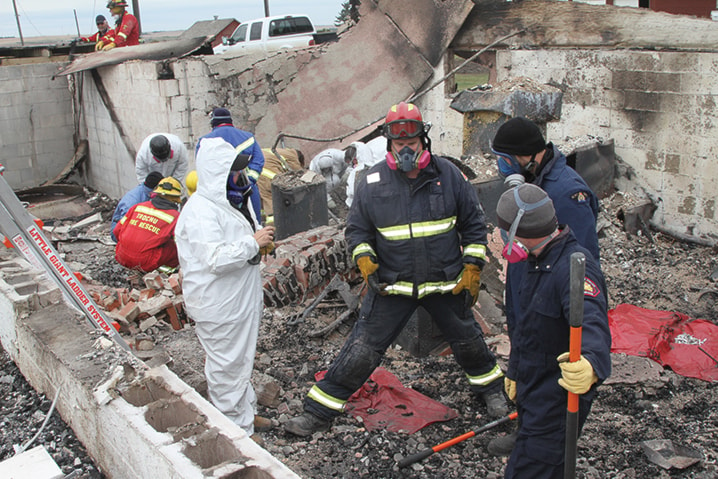HUXLEY — In forensics jargon, they are called cremains.
Short for cremated remains, they can turn a house fire into a crime scene when investigators know what to look for.
More than a dozen firefighters, peace officers and police officers were out at a farmstead near Huxley on Friday as part of a four-day crash course in fire forensics.
Sifting through the ruins of an old farmhouse burned to the ground earlier in the week, teams painstakingly searched through the ash and debris to piece together a mock crime scene.
Pig carcasses donated by a local Hutterite colony served as the victims.
Joe Towers, a fire investigator with Red Deer Emergency Services until five years ago and now heading his own company Global Forensics Inc., was among experts passing on their knowledge.
Towers said the program was put together after a fourth-floor arson fire in Red Deer a number of years ago. Fire investigators identified the points of origin and ignition sources for the fire.
However, when RCMP forensic officers arrived they were looking for different clues.
“They said, did you see the blood spatter? Did you see the blood on the walls going out of the apartment?
“We weren’t trained in that, so we didn’t see it.”
Likewise, the police investigators didn’t know how to pinpoint where a blaze began or what may have started it.
Out of that experience, a joint fire and RCMP course was put together.
Besides sharing investigative techniques, participants learn about forensic photography and interviewing, collecting evidence, blood spatters and other blood evidence. An RCMP anthropologist is brought in to demonstrate how to find bones among debris or fields. An entomologist explains what bugs can teach investigators about crime scenes and pinpointing times of death through fly larvae.
“Bugs and bones is what we call it,” he said of that course section.
The first day of the course involves scenarios where there has been no fire.
Participants are taught how to move about a scene without contaminating evidence. How to document and photograph scenes and collect foot and tire imprints.
Firefighters specifically are taught how to knock down a fire without destroying potential evidence.
At the end of the program, all had to poke through the ruins of the house to find evidence of carcasses, even shell casings or bullets that had been used to put down the pigs, which had not been healthy.
Later, a burned-out vehicle containing a pig carcass was to be used for a similar purpose.
Finding remains is no easy task. Searchers clothed in coveralls, rubber boots and faces masks pore through the debris. Fragments of white bone can show little distinction from chunks of masonry or other building materials.
However, despite the near-complete destruction, fingerprints and blood evidence were found in the ruined home.
Trochu fire Capt. Bill Wohl, who is also a fire investigator, said the exercise has a lot of value to his 22-strong department.
“The biggest thing I get out of this is how I can assist with the law enforcement end of it, and preservation of evidence and the way we do things.
“The old saying is firefighters look down and police look up,” he said.
“This taught us to take more care and be more aware,” he said.
His volunteers were also able to set the fires and show police and others how they spread and what clues are left behind.
Westlock County peace officer Erik Nickolson found it eye opening how much damage there was to sift through and the state of some of the remains. Some of the bone evidence crumbled as soon it was picked up.
“At the scene, you definitely only get one shot at this so you have to make sure that you’re really looking and pay attention.
“One of the biggest things I’ve found is the bones look a lot like everything else. Unless you know what you’re looking for, it can be quite difficult.”
pcowley@www.reddeeradvocate.com
